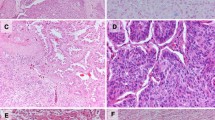Abstract
Stepwise progression of pulmonary adenocarcinoma is described from the viewpoint of both pathology and molecular biology. Pulmonary adenocarcinoma develops to invasive carcinoma through atypical adenomatous hyperplasia, adenocarcinoma in situ and minimally invasive adenocarcinoma. The Noguchi classification is well correlated with this sequential histological progression. On the other hand, in terms of molecular biology, p16 gene inactivation, EGFR mutation and KRAS mutation are early events, and tumors progress to invasive adenocarcinoma as a result of p53 mutation, loss of various chromosomes and other genetic abnormalities.








Similar content being viewed by others
References
Travis, W. D., Lubin, J., Ries, L., & Devesa, S. (1996). United States lung carcinoma incidence trends: declining for most histologic types among males, increasing among females. Cancer, 77, 2464–2470.
Valaitis, J., Warren, S., & Gamble, D. (1981). Increasing incidence of adenocarcinoma of the lung. Cancer, 47, 1042–1046.
Travis, W. D., Travis, L. B., & Devesa, S. S. (1995). Lung cancer. Cancer, 75, 191–202.
Travis, W. D., Colby, T. V., Corrin, B., et al. (1999). WHO histological typing of lung and pleural tumors (3rd ed.). Geneva: World Health Organization.
Travis, W. D., Brambilla, E. B., Muller-Hermelink, H. K., & Harris, C. C. (2004). WHO pathology and genetics of tumours of the lung, pleura, thymus and heart. Lyon: IARCPress.
Yatabe, Y., Mitsudomi, T., & Takahashi, T. (2002). TTF-1 expression in pulmonary adenocarcinomas. American Journal of Surgical Pathology, 26, 767–773.
Nakayama, H., Noguchi, M., Tsuchiya, R., Kodama, T., & Shimosato, Y. (1990). Clonal growth of atypical adenomatous hyperplasia of the lung: cytofluorometric analysis of nuclear DNA content. Modern Pathology, 3, 314–320.
Anami, Y., Matsuno, Y., Yamada, T., et al. (1998). A case of double primary adenocarcinoma of the lung with multiple atypical adenomatous hyperplasia. Pathology International, 48, 634–640.
Noguchi, M., Morikawa, A., Kawasaki, M., et al. (1995). Small adenocarcinoma of the lung. Histologic characteristics and prognosis. Cancer, 75, 2844–2852.
Nakamura, N., Iijima, T., Mase, K., et al. (2004). Phenotypic differences of proliferating fibroblasts in the stroma of lung adenocarcinoma and normal bronchus tissue. Cancer Science, 95, 226–232.
Minami, Y., Matsuno, Y., Iijima, T., et al. (2005). Prognostication of small-sized primary pulmonary adenocarcinomas by histopathological and karyometric analysis. Lung Cancer, 48, 339–348.
Suzuki, K., Yokose, T., Yoshida, J., et al. (2000). Prognostic significance of the size of central fibrosis in peripheral adenocarcinoma of the lung. Annals of Thoracic Surgery, 69, 893–897.
Yokose, T., Suzuki, K., Nagai, K., Nishiwaki, Y., Sasaki, S., & Ochiai, A. (2000). Favorable and unfavorable morphological prognostic factors in peripheral adenocarcinoma of the lung 3 cm or less in diameter. Lung Cancer, 29, 179–188.
Sakurai, H., Maeshima, A., Watanabe, S., et al. (2004). Grade of stromal invasion in small adenocarcinoma of the lung: histopathological minimal invasion and prognosis. American Journal of Surgical Pathology, 28, 198–206.
Sakamoto, H., Shimizu, J., Horio, Y., et al. (2007). Disproportionate representation of KRAS gene mutation in atypical adenomatous hyperplasia, but even distribution of EGFR gene mutation from preinvasive to invasive adenocarcinomas. Journal of Pathology, 212, 287–294.
Kobayashi, T., Tsuda, H., Noguchi, M., et al. (1990). Association of point mutation in c-Ki-ras oncogene in lung adenocarcinoma with particular reference to cytologic subtypes. Cancer, 66, 289–294.
Mok, T. S., Wu, Y. L., Yu, C. J., et al. (2009). Randomized, placebo-controlled, phase II study of sequential erlotinib and chemotherapy as first-line treatment for advanced non-small cell lung cancer. Journal of Clinical Oncology, 27, 5080–5087.
Paez, J. G., Janne, P. A., Lee, J. C., et al. (2004). EGFR mutations in lung cancer: correlation with clinical response to gefitinib therapy. Science, 304, 1497–1500.
Lynch, T. J., Bell, D. W., Sordella, R., et al. (2004). Activating mutations in the epidermal growth factor receptor underlying responsiveness of non-small cell lung cancer to gefitinib. New England Journal of Medicine, 350, 2129–2139.
Takano, T., Ohe, Y., Sakamoto, H., et al. (2005). Epidermal growth factor receptor gene mutations and increased copy numbers predict gefitinib sensitivity in patients with recurrent non-small-cell lung cancer. Journal of Clinical Oncology, 23, 6829–6837.
Shigematsu, H., Lin, L., Takahashi, T., et al. (2005). Clinical and biological features associated with epidermal growth factor receptor gene mutations in lung cancers. Journal of the National Cancer Institute, 97, 339–346.
Yatabe, Y., Takahashi, T., & Mitsudomi, T. (2008). Epidermal growth factor receptor gene amplification is acquired in association with tumor progression of EGFR-mutated lung cancer. Cancer Research, 68, 2106–2111.
Matsumoto, S., Iwakawa, R., Kohno, T., et al. (2006). Frequent EGFR mutations in noninvasive bronchioloalveolar carcinoma. International Journal of Cancer, 118, 2498–2504.
Tanaka, R., Wang, D., Morishita, Y., et al. (2005). Loss of function of p16 gene and prognosis of pulmonary adenocarcinoma. Cancer, 103, 608–615.
Nakanishi, H., Matsumoto, S., Iwakawa, R., et al. (2009). Whole genome comparison of allelic imbalance between noninvasive and invasive small-sized lung adenocarcinomas. Cancer Research, 69, 1615–1623.
Sato, K., Ueda, Y., Shikata, H., & Katsuda, S. (2006). Bronchioloalveolar carcinoma of mixed mucinous and nonmucinous type: immunohistochemical studies and mutation analysis of the p53 gene. Pathology, Research and Practice, 202, 751–756.
Soda, M., Choi, Y. L., Enomoto, M., et al. (2007). Identification of the transforming EML4-ALK fusion gene in non-small-cell lung cancer. Nature, 448, 561–566.
Inamura, K., Takeuchi, K., Togashi, Y., et al. (2008). EML4-ALK fusion is linked to histological characteristics in a subset of lung cancers. Journal of Thoracic Oncology, 3, 13–17.
Tanaka, R., Ishiyama, T., Uchihara, T., et al. (2006). Expression of the Bax inhibitor-1 gene in pulmonary adenocarcinoma. Cancer, 106, 648–653.
Author information
Authors and Affiliations
Corresponding author
Rights and permissions
About this article
Cite this article
Noguchi, M. Stepwise progression of pulmonary adenocarcinoma—clinical and molecular implications. Cancer Metastasis Rev 29, 15–21 (2010). https://doi.org/10.1007/s10555-010-9210-y
Published:
Issue Date:
DOI: https://doi.org/10.1007/s10555-010-9210-y




